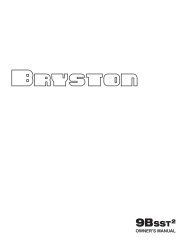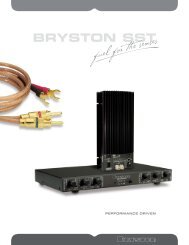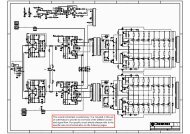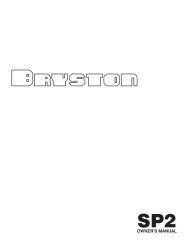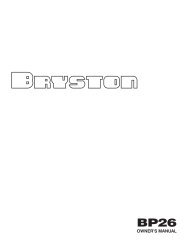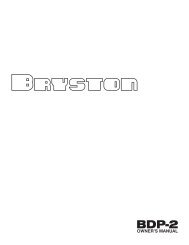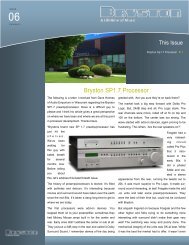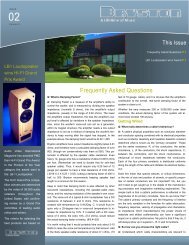Volume 7, Issue 2 - Bryston
Volume 7, Issue 2 - Bryston
Volume 7, Issue 2 - Bryston
Create successful ePaper yourself
Turn your PDF publications into a flip-book with our unique Google optimized e-Paper software.
I S S U E<br />
02<br />
V o l u m e 7<br />
This <strong>Issue</strong><br />
The PMC Transmission Line Design P.1<br />
What Do <strong>Bryston</strong><br />
And Chicago<br />
Have In Common?<br />
<strong>Bryston</strong> is pleased to announce<br />
that the latest blockbuster<br />
movie CHICAGO was<br />
recorded using <strong>Bryston</strong> Amplifiers<br />
and a <strong>Bryston</strong> 280B<br />
Dolby Noise Reduction Unit.<br />
Chicago has received 13<br />
OSCAR nominations including<br />
both Music and Sound.<br />
For those not familiar with<br />
the <strong>Bryston</strong> 280B Dolby<br />
Noise Reduction unit it is a<br />
specialized product we<br />
manufacture which is used in<br />
combination with a Nagra<br />
Analog tape recorder for<br />
doing on-sight location<br />
sound recording for major<br />
feature films.<br />
Mr. David Lee the location<br />
sound recording engineer on<br />
the movie Chicago is up for<br />
an OSCAR for his work on<br />
this project. David has already<br />
won the United Kingdoms<br />
version of the OSCAR<br />
(Bafta) for his work on the<br />
film.<br />
<strong>Bryston</strong> 4B amplifiers were<br />
also used for the on-location<br />
playback system.<br />
What Do <strong>Bryston</strong> And Chicago Have in Common? P.1<br />
<strong>Bryston</strong> SST Series Gets Class A Ratting P.2<br />
The PMC Transmission Line Design<br />
As you may know <strong>Bryston</strong> distributes the PMC Transmission<br />
Line Loudspeakers in North America. I have<br />
had numerous questions over the years as to what<br />
transmission line technology is all about - so here<br />
goes ...<br />
There are three main types of dynamic loudspeaker<br />
enclosure designs:<br />
Infinite baffle (Closed box)<br />
of the Chunnel.<br />
The most practical implementation is to create a long<br />
tunnel within a cabinet by introducing internal partitioning<br />
that folds the line up and down the length of the<br />
cabinet (see figure 1). At the very end of the line there<br />
is a very specific size of opening that vents directly<br />
into the room. A major benefit to this construction is<br />
that the labyrinth (partitioning) braces the entire structure<br />
from beginning to end. This nearly eradicates<br />
Reflex (Ported)<br />
Transmission line<br />
All of the above use conventional<br />
moving coil drive units<br />
of varying cone size and<br />
dome material.<br />
The transmission line (TL),<br />
though much more complex<br />
cabinet colouration created by the effects of the outer<br />
walls of the cabinet flexing which<br />
is a serious problem with other<br />
loudspeaker box designs. Cabinet<br />
integrity and internal panel<br />
damping are essential to produce<br />
a successful design due to<br />
the TL’s inherent ability to produce<br />
in execution, is considered to<br />
phenomenal Low Fre-<br />
be the theoretical ideal and<br />
quency extension (pressure),<br />
represents the most complex<br />
construction techniques available<br />
to load a moving coil<br />
loudspeaker design. The basic<br />
concept is that ‘ALL’ of the<br />
rear wave information coming<br />
off of the woofer - or any loudspeaker driver for that<br />
matter - would be absorbed by the enclosure (box)<br />
behind the woofer. In the real world this ideal is obviously<br />
impossible as the speaker box would be the size<br />
even from a modest size box.<br />
The main driver is placed at one<br />
end of the TL, which is heavily<br />
damped with absorbent acoustic<br />
material. The most predictable<br />
and accurate absorber is a<br />
highly specified foam material that in PMC’s products<br />
took a vast amount of R&D to derive the correct formula<br />
of profile, pore size and density of the polymer.<br />
The foam, probably the least visually dramatic of the
<strong>Bryston</strong> SST Series<br />
Gets Class A<br />
Rating<br />
<strong>Bryston</strong> is pleased to announce<br />
that the 14B SST<br />
and the 9B SST have received<br />
Class A ratings in the<br />
April 2003 issue of Stereophile<br />
Magazine.<br />
There is also a great follow<br />
up review in the same issue<br />
on the 7B SST by Larry<br />
Greenhill. Larry comments<br />
that the new 7B SST "was<br />
neutral, as neutral, in fact, as<br />
<strong>Bryston</strong>s new 14B SST". We<br />
expect to receive a Class A<br />
Rating on the 7B SST as<br />
well once a full review is<br />
done.<br />
These new SST Series amplifiers<br />
are being recognized<br />
the world over as the best<br />
available regardless of price.<br />
components is tremendously important. It has to absorb<br />
all the upper bass frequencies and allow the<br />
lower frequencies to exit the vent at the far end of the<br />
line ‘in phase’ with the main driver. It must also be<br />
exactly specified to ensure a consistent and balanced<br />
backpressure on the driver by interfacing smoothly<br />
with the column of air within the line. With too higher<br />
damping, the driver cannot move freely enough, and<br />
conversely too little damping produces a lack of control<br />
and the result is a low frequency response similar<br />
to that of a regular ported reflex design.<br />
When this equilibrium is achieved between the length<br />
of line and the acoustic absorbency, the air density<br />
increases by up to 30% making the ‘effective’ line<br />
length far greater than it’s physical length. This backpressure<br />
holds the main driver in a vice like grip and<br />
the control is effective over a huge frequency range,<br />
reducing unwanted cone movement which lowers audible<br />
distortion. This lack of harmonic distortion in the<br />
low frequency creates superb midrange clarity as it<br />
eradicates the effects of midrange and high frequency<br />
masking caused by a lack of control on low frequency<br />
drivers. The consistent air loading also facilitates full<br />
frequency bandwidth at all listening levels allowing for<br />
extended periods of monitoring without the risk of fatigue.<br />
In other words, the speaker sounds dynamic<br />
and balanced at all listening levels.<br />
So the main advantages of the TL design:<br />
Lower distortion<br />
Improved driver control<br />
Higher SPL<br />
Lower bass extension from a given box size<br />
Consistent balance at all levels<br />
If you realize that in fact musical signals are a transient<br />
condition then all this technology kind of falls into<br />
place. The ability of the loudspeaker to ‘start and stop’<br />
on command without delay or overhang has obvious<br />
major sonic advantages. The loudspeaker follows the<br />
signal from the amplifier much more precisely and the<br />
result is much more accurate translation of the original<br />
input signal.<br />
Believe me once you get use to transparency, transient<br />
response and lower distortion available from<br />
properly designed Transmission Line loudspeakers<br />
there is no going back.<br />
<strong>Bryston</strong> Ltd.<br />
677 Neal Drive<br />
Peterborough, Ontario<br />
CANADA<br />
K9J 6X7<br />
Phone: 705-742-5325 or 1-800-632-8217<br />
Fax: 705-742-0882<br />
Email: contact@bryston.com<br />
Web: http://www.bryston.com<br />
Editor: James Tanner, Vice President of Sales and Marketing<br />
Email: jamestanner@bryston.com



